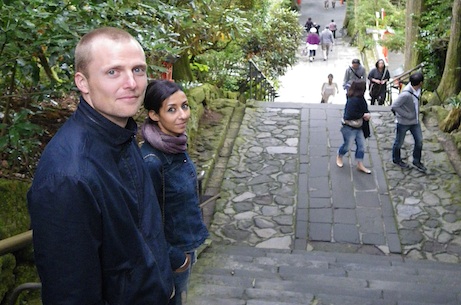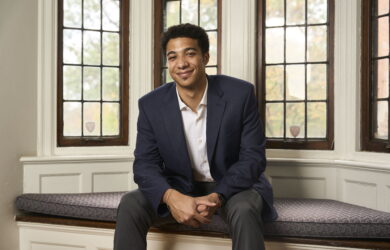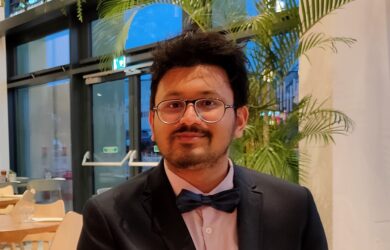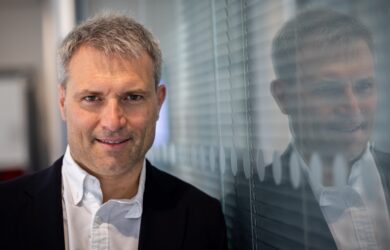
Mikkel Oestergaard is looking at how genomics can help tackle the growing impact of chronic illnesses in developing countries.
People tend to think that chronic diseases such as cancer are illnesses of wealthy countries, but increasingly they make up a major share of the public health burden in developing countries.
In richer countries there is a lot of focus on genomics – understanding the genetic links to chronic disease, but Gates Cambridge Alumnus Mikkel Oestergaard [2005] wants to harness genomics to tackle the rising problems in developing countries.
He and colleagues have surveyed international science and public health experts to gather data on the major bottlenecks preventing developing countries from benefitting from genomics.
He says it is the largest survey of its kind and he is hopeful it can make a real difference to public health around the world.
The work follows on from his work both at the World Health Organization to develop evidence to guide health system funding priorities and now at the biotechnology company Roche on cancer drug development as well as his MPhil and PhD on cancer genomics at Cambridge.
Mikkel’s MPhil in Epidemiology at Cambridge focused on genetic susceptibility to breast cancer, a subject he continued into his PhD. “I have had a strong interest in cancer since my grandmother died of it. It triggered something in me,” he says.
His research involved comparing the genomes of sick people with healthy people in order to find what genetic differences they had and whether these put them at a higher risk of cancer. Mikkel’s work was not focused on what happens in a single cell, but at the system-level. “I was interested in how cells and pathways work together and how something in one part of the body affects another part,” he says.
His research brought together epidemiological studies at a population level with what happens at a molecular level. Because it crossed over two different areas he had two supervisors, one at Harvard Medical School and one in Cambridge. “I wanted to integrate what we see at a population level with what happens at the molecular level using genome-wide data. This was something that had not been addressed much before, but has been increasingly made possible due to technological improvements in genetic sequencing,” says Mikkel. “I developed computational methods to integrate these two. By understanding which genes are functionally linked you can narrow down a hypothesis at the population level in order to test it better. In the past scientists have selected which genes to test based on little data and often a quite subjective understanding of what constitutes good disease candidate genes. Scientists are more likely to be successful if unbiased objective data informs their selection of hypotheses.”
His research led to him winning the prestigious Future Leaders, New Directions Award from the American Association for Cancer Research.
WHO
After finishing his PhD in 2009, Mikkel wanted a change from academia. He felt it was too far removed from implementation and improvements in clinical and public health care. However, his skills were more analytical. He applied to the World Health Organization HQ in Geneva where he began working on estimating the burden of disease in different countries, calculating how many people were dying and what they were dying of. His particular focus was on child and maternal mortality, creating statistical models for how to calculate how many children were dying under five, under one and in their first four weeks of life. The statistics are used by policymakers and NGOs to allocate funding and set priorities. Annually three million babies die in their first four weeks of life, 98% of whom are in developing countries. Most die from preventable diseases, from complications of pre-term delivery and infections. At least a third of the deaths are preventable by very simple measures such as increased hygiene and better training of midwives.
“It’s so sad that the vast majority of deaths among newborns are preventable, but we’ve never had the numbers to know how big the problems are so we can scale the resources to fit,” says Mikkel.
A year ago he moved to Roche where he is using his genomics background and analytical skills to support discovery and development of therapeutic treatments for cancers. “They have this approach which is about understanding the biology of disease and developing molecules that can kill cancer cells in a targeted way, unlike chemotherapy which kills any cell,” he says.
Background
Mikkel, who was born in Copenhagen, grew up in a medical family. His father is a doctor and his mother is a nurse. He is the youngest of five children, although three are half-siblings. Although the half-siblings did not live in the same house as him Mikkel says the siblings considered themselves a pack.
Mikkel was a good all rounder at school and enjoyed chess at primary school. By high school he was leaning towards sciences. He was also very interested in sport and played tennis, competing in national tournaments until his late teens. He has continued his interest in sport and is currently competing in ultra endurance ironman triathlons after teaching himself to swim a year ago.
After leaving school, he did his military service and spent a year working as a land surveyor and playing tennis before travelling to Ecuador to work on rainforest conservation. He also worked in Guatemala with an NGO which was working with local indigenous groups excavating the mass graves of victims killed during the recent civil war.
In 2000, he started a degree in biochemistry at the University of Copenhagen. However, it was not until the night before he applied that he decided what he wanted to study. “I had very broad interests in literature, law and medicine. The night before I had medicine written on my application,” he says. He switched to biochemistry because he wanted something more scientific.
At university he volunteered as a mentor for international students to help them settle academically and socially. During one summer vacation he went to the University of California Berkeley for a course in international human rights and later did a dissertation on doctors’ responsibility regarding violations of human rights.
He says making a difference, the leitmotif of the Gates Cambridge Trust, is something he is very committed to. His work on public health is just the beginning.












